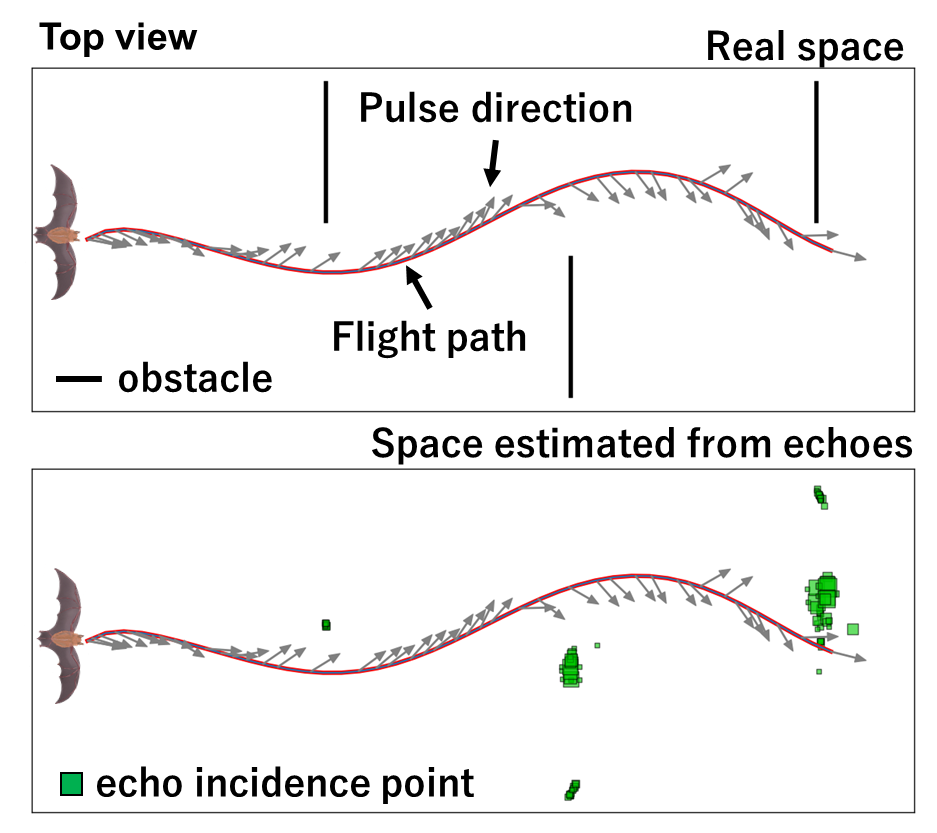Research News: Spaces and Echoes: Scientists Reveal What Bats “See” through Sound
May 27, 2022
Measuring the echoes heard by bats, researchers show that bats perceive spaces differently through echolocation than humans do visually
Unlike humans, bats use sound information to understand and navigate their surroundings. However, the precise signals they use for such echolocation are difficult to measure. Using a combination of simulation and behavioral experiments, scientists from Japan reproduced and measured the echoes perceived by bats during flight, revealing how they navigate even through complex environments with obstacles. These findings lay the foundation for more efficient echo-sensing in various engineering applications.
Vision is the predominant sense in humans, and we heavily rely on our sight for understanding our surroundings. As a result, image recognition-based technologies have been rapidly developed and are being applied to areas such as automated driving. However, some animals do not have good visual acuity and therefore use different sensory cues to navigate their environments. For example, bats primarily perceive their environment through a process called echolocation—a form of acoustic sensing in which animals emit sounds and perceive their environments based on the returning echoes. While the concept of echolocation is fairly well-known, the actual echoes heard by bats have been challenging to measure. As such, the precise mechanics of echo-sensing used by bats and the input–output relationships of these signals have remained a mystery.
In a recent study published in BMC Biology in March 2022, a team of scientists from Doshisha University and Hiroshima University revealed what bats “see” through echolocation. “We wanted to understand how bats use echo cues to identify obstacles and create a flight plan. To do this, we detected the spatiotemporal changes in the echoes sensed by bats and visualized what they perceive as ‘space’ during flight. We called this the ‘echo space’ of the bats,” comments Yu Teshima, a doctoral student, who spearheaded this study along with Prof. Shizuko Hiryu and Prof. Takao Tsuchiya from Doshisha University.
The Japanese team is now the first to reveal the “echo space” that bats “see” through sound. However, the road to this destination was not easy. “Our understanding of echolocation mechanics has been limited because even the most advanced devices cannot measure all the echoes that reach a bat during its flight,” explains Prof. Hiryu. To solve this problem, Prof. Hiryu and her team used a combination of acoustic simulations and performed behavioral experiments in bats. These experiments allowed them to reproduce the echoes that a bat receives during its flight and understand how the bat uses these inputs to control its behavior, see obstacles, and accordingly navigate its environment.
Interestingly, the team found that the space bats perceive through echolocation is very different from what humans perceive through their vision. Next, they tested whether this “echo space” changes as bats become more familiar with their environment. That is, can the bats start to focus on the relevant objects in their environment? Interestingly, they found that as bats become more familiar with their environment, their echo space becomes narrower and gets restricted to only those areas and objects that are important for their flight. This indicated that bats show adaptive learning and navigation behavior by fine-tuning their echo space. Another key finding of this study was that the direction of the echo correlated with the turns taken by bats during flight, revealing—for the first time—the how the echo direction determines the bat’s flight path.
The findings from this study have now answered fundamental and long-standing questions about the mechanics involved in echolocation. Thus, they are expected to propel significant advancements in echolocation-related applications. “So far, our sound-based location applications are limited to estimations of distance, such as sound navigation and ranging (SONAR). However, the input–output relationship we have elucidated in bats can be used to develop advanced sensors that can provide more comprehensive information, even under dark conditions!” exclaims Prof. Hiryu.
Indeed, when these new technologies become available, we will have Prof. Hiryu’s team—and bats—to thank!

A comparison of actual versus simulated flight space for the bats
Researchers from Japan use simulations and behavioral tests in bats to understand how they perceive the space around them through echolocations
Image courtesy: Yu Teshima, Takao Tsuchiya, and Shizuko Hiryu from Doshisha University
Usage restrictions: Cannot be reused without permission
Reference
| Title of original paper | Analysis of echolocation behavior of bats in “echo space” using acoustic simulation |
| Journal | BMC Biology |
| DOI | 10.1186/s12915-022-01253-y |
| Latest article publication date | March 14th, 2022 |
| Method of research | Experimental study |
| Subject of research | Animals |
| Conflict of interest | The authors have declared that no competing interests exist |
Funding information
This study was supported by the JSPS KAKENHI Grant Numbers JP 18H03786 and 21H05295 as well as the JSPS Postdoctoral Fellowship. The funders had no role in study design, data collection and analysis, decision to publish, or preparation of the manuscript.
Profiles

Yu Teshima
Doctoral student, Faculty of Life and Medical Sciences
Yu Teshima is a doctoral student at the Faculty of Life and Medical Sciences, Doshisha University. He completed his M.E. from Doshisha University in 2016. His research focuses on bioacoustics. In 2020, he received the 2020 System Integration Award for Outstanding Presentation by System integration division in Society of Instrument and Control Engineers. He has also won six other awards at other conferences.
Shizuko Hiryu
Professor, Faculty of Life and Medical Sciences, Department of Biomedical Information
Prof. Shizuko Hiryu is a Professor at the Faculty of Life and Medical Sciences Department of Biomedical Information, Doshisha University. She received her PhD from the Graduate School of Engineering, Doshisha University, in 2006. She previously served as the Research Director of PRESTO, Strategic Basic Research Programs, Japan Science and Technology Agency. Her main research interests lie in bioacoustics, measurement engineering, and ultrasonic engineering. She has published over 100 research papers across well-reputed journals and was awarded the JSPS Prize in 2018.
Media contact
Organization for Research Initiatives & Development
Doshisha University
Kyotanabe, Kyoto 610-0394, JAPAN
CONTACT US
